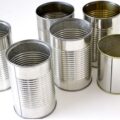Coatings for metal containers include a variety of chemical compounds designed to protect both the contents of the container and the metal against corrosion, deterioration and to maintain the quality of the packaged product. Among the most common types of coatings are:
- Epoxy type: Phenolic epoxy coatings are very effective for both food and non-food applications. They offer chemical resistance, excellent adhesion to the metal substrate, good flexibility (necessary for the formation of containers) and high resistance to sterilization at high temperatures. They are not used alone, since they do not withstand high degrees of metal deformation, so they are mixed with phenolic resins in proportions of 3/1 and 6/1 (epoxy/phenolic ratio).
- Acrylic, polyester or alkyd type: These coatings are analogous to exterior coatings and are used without pigmentation. They may include additives to improve their lubricity and are generally designed to provide gloss to the container.
- Epoxy ester: A combination of an epoxy-type resin with a fatty acid and a crosslinking agent.
- Polymeric coatings on metals: They are generally applied on chrome plate or aluminum and may include polyethylene terephthalate (PET) or polypropylene (PP), pigmented or not. This technology is claimed to offer significant energy savings and environmental benefits compared to liquid-based coatings.
- Composite coatings: These are the combination of a metallic coating (generally anodic type) with layers of organic coatings (paints), which generate a synergistic effect between the two, providing a protective capacity greater than the sum of the individual capacities of each coating.
- Powder coatings: Involve the electrostatic deposition of very small solid particles on the substrate, followed by a cure that melts the particles creating a continuous film.
- Seam and incision repair varnishes: These are applied to protect specific areas of the package, such as the seam and incision, and can be of modified epoxy type, among others.
It is important to mention that coatings must comply with specific regulations to ensure that they are safe for human health and do not alter the organoleptic characteristics of the packaged product.














0 Comments